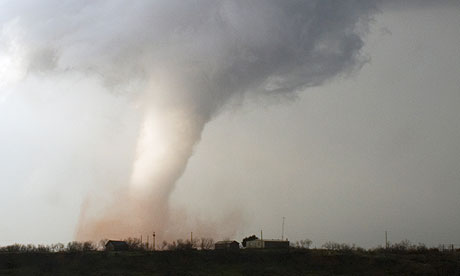
A rash of tornados whirled through small communities in North Texas overnight, leaving at least six people dead, dozens more injured and hundreds homeless. The violent spring storm threw trailers onto cars, blew windows from houses and scattered bodies far from their homes.
In Granbury, the worst-hit city, a tornado tore through two neighborhoods around 8 p.m. Wednesday. Resident Elizabeth Tovar described the fist-sized hail that heralded the tornado's arrival and prompted her and her family to hide in their bathroom.
"We were all, like, hugging in the bathtub, and that's when it started happening. I heard glass shattering, and I knew my house was going," Tovar said, shaking her head. "We looked up and … the whole ceiling was gone."
Local authorities had a news conference scheduled for 8 a.m. CT to outline the extent of the damage visible after daybreak.
Behind one house in the storm's path, a detached garage was stripped of much of its aluminum siding, the door caved in and the roof torn off. A tree behind the house was stripped of most of its branches and a vacant doublewide mobile home on an adjoining lot was torn apart.
Daniel and Amanda Layne initially thought they were safe sheltering under their carport. But then "it started getting worse and worse," and the couple took shelter in their bathroom, Daniel Layne said.
"The windows and the cars are gone. Both our cars are messed up. I had a big shop. Ain't a piece of it left now," Layne said with a shrug.
Hood County Sheriff Roger Deeds described the devastating aftermath and the hunt for bodies.
"Some were found in houses. Some were found around houses," Deeds said. "There was a report that two of these people that they found were not even near their homes. So we're going to have to search the area out there."
He said officials were trying to account for 14 people.
About 50 people were taken to a Granbury hospital, where 14 were admitted for treatment of injuries and two were transferred to a hospital in Fort Worth, about 35 miles to the northeast, Deeds said. Yet more gathered at a local elementary school where paramedics provided on-site treatment. Matt Zavadsky, a spokesman for MedStar Mobile Healthcare, estimated that as many as 100 people were injured.
Another tornado that storm spotters told the National Weather Service was a mile wide tore through Cleburne, a courthouse city of about 30,000 about 25 miles southeast of Granbury.
There were no reports of deaths in that storm, Cleburne Mayor Scott Cain said, "but we do have the potential for some injuries." In one neighborhood, a trucking company trailer that had been parked on the street was picked up and dropped onto a nearby car and garage.
Cain estimated that dozens of homes were damaged.
Another tornado hit the small town of Millsap, about 40 miles west of Fort Worth. Parker County Judge Mark Kelley said roof damage was reported to several houses and a barn was destroyed, but no injuries were reported.
Hail as large as grapefruit also pelted the area around Mineral Wells on Wednesday evening. A police dispatcher reported only minor damage.
Thursday 16 May 2013
http://www.cbc.ca/news/world/story/2013/05/15/texas-tornado.html




